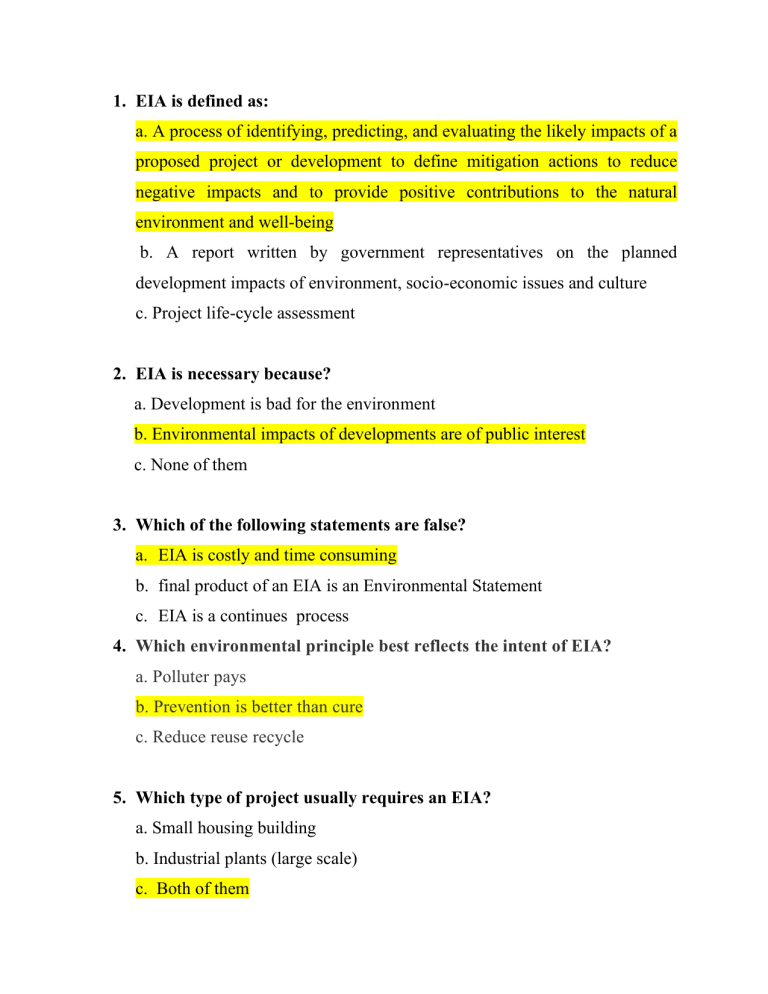
1. EIA is defined as: a. A process of identifying, predicting, and evaluating the likely impacts of a proposed project or development to define mitigation actions to reduce negative impacts and to provide positive contributions to the natural environment and well-being b. A report written by government representatives on the planned development impacts of environment, socio-economic issues and culture c. Project life-cycle assessment 2. EIA is necessary because? a. Development is bad for the environment b. Environmental impacts of developments are of public interest c. None of them 3. Which of the following statements are false? a. EIA is costly and time consuming b. final product of an EIA is an Environmental Statement c. EIA is a continues process 4. Which environmental principle best reflects the intent of EIA? a. Polluter pays b. Prevention is better than cure c. Reduce reuse recycle 5. Which type of project usually requires an EIA? a. Small housing building b. Industrial plants (large scale) c. Both of them 6. The source of carbon to plants in the carbon cycle is a. Fossil fuels b. Atmospheric carbon dioxide c. All of the above 7. In the carbon cycle, the human body returns carbon to the atmosphere through this way: a. Waste products b. Photosynthesis c. Cellular respiration 8. Respiration and photosynthesis processes are central to: a. Nitrogen cycle a. Carbon cycle b. Water cycle 9. What does sustainability mean? a. Avoiding the depletion of natural resources in order to maintain ecological balance. b. Using only fossil fuels c. Using only non-renewable resources 10. ----------- is the effect of undesirable changes in our surroundings that have harmful effects on plants, animals and human beings. 1. Pollution 2. Deforestation 3. Climate change 11. In project description developers should provide an overview of ……… a. The location b. The physical characteristics of Project c. The characteristics of the operational phase of the Project d. All of the above 12. In air quality impact assessment chapter ………….. is descripted. a. The Potentially Hazardous Facilities (PHI) for the Project. b. The potential noise impact c. The potential air quality impact 14. Terms of Reference include………. a. A description of the process b. Final EIA c. None of the above 15. The final product of an EIA is………… a. Environmental Statement b. Project Description c. None of the above 16. The EIA report needs to be based on ……….. a. Accurate information b. Relevant information c. Both of the above 17. An EIA should allow …….. a. Decision makers to understand a project’s impacts b. The public to present their views and inputs on the planned development c. Both of the above 18. Landscape and Visual Impact Assessment include………. a. Environmental legislation and guidelines b. Define the nature and scale of the potential impacts on cultural heritage resources associated with the Project. c. Provide data to enable an environmental audit. True or False? 1. EIA allows decision makers to assess a project’s impacts in all its phases a. True b. False 2. Environment impacts are only negative impacts a. True b. False 3. EIA allows the public and other stakeholders to present their views and inputs on the planned development a. True b. False 4. EIA is a study to identify, predict, evaluate, and communicate information about the impacts on the environment of a proposed project and to detail out the mitigating measures prior to project approval and implementation. a. True b. False 5. EIA is usually required for a development project a. True b. False 6. Impact assessment is done for the planned project. a. True b. False 7. The objective of EIA to investigate the environmental acceptability only during operation of the Project a. True b. False 8. The Baseline is a description of the current status of the environment in and around the area in which the Project will be located. a. True b. False 9. The objective of EIA to investigate the environmental acceptability during construction and operation of the Project. a. True b. False 10.Environmental Impact Assessment include Monitoring and Evaluation only a. True b. False 11.Monitoring serves two purposes a. True b. False 12.The EIA report provides information to decision makers later to issuing an operating license a. True b. False 13. In writing an EIA Report the first step is to make a draft for EIA report a. True b. False

